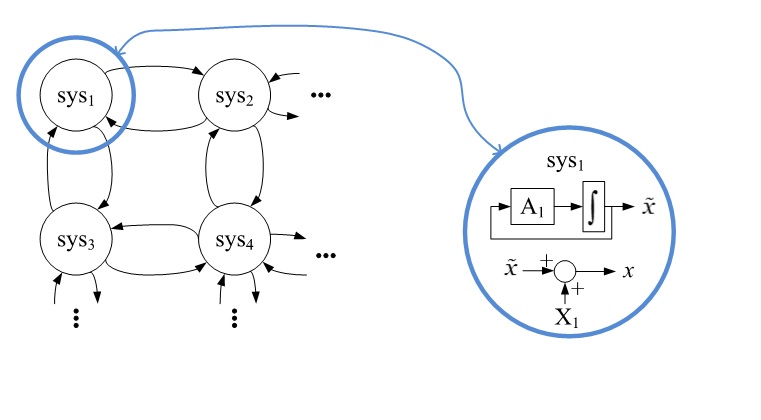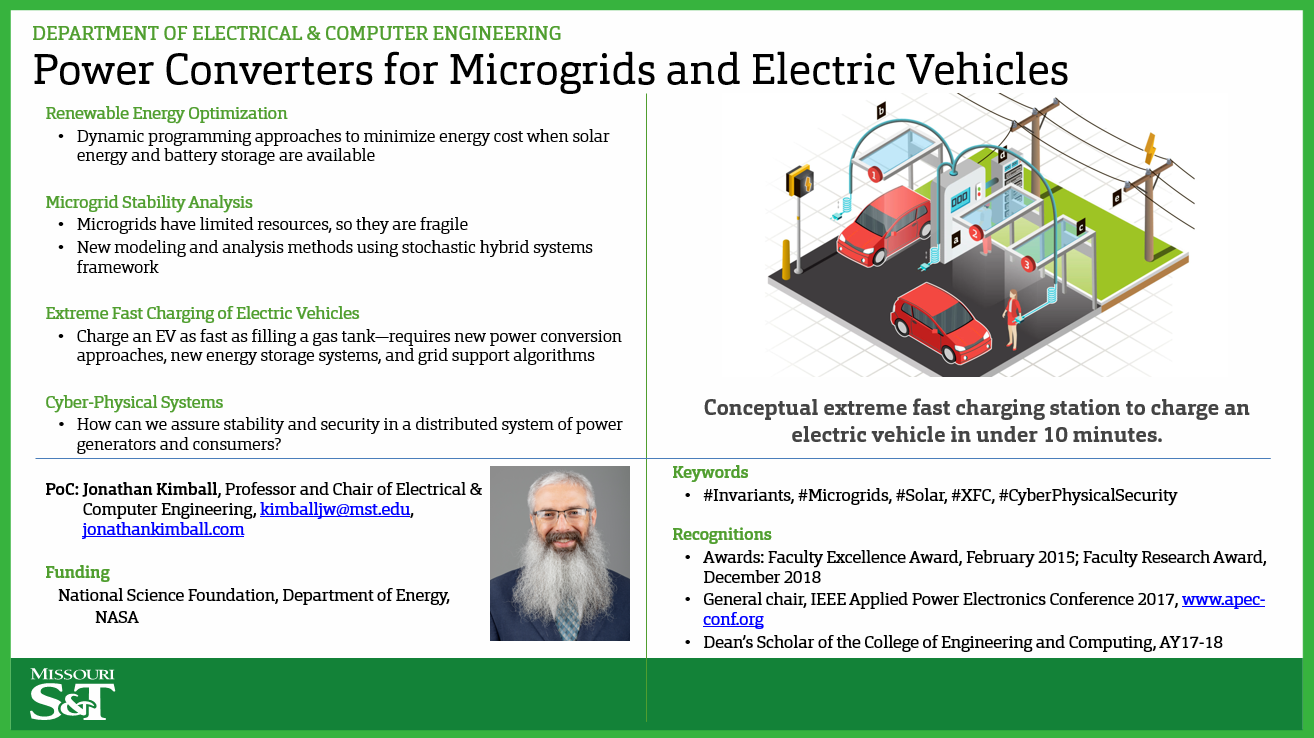Jonathan Kimball
Department Chair and Fred W. Finley Distinguished Professor
Electrical and Computer Engineering
- kimballjw@mst.edu
- Phone: (573) 341-4503
- 139 Emerson Hall
Publications:
Resume/CV:
Personal Website:
- Cyber-Physical System Security Using Invariants
- Grid-Tie Converter Control and Modeling for Microgrids
- Stochastic Modeling of Microgrids and Loads
Cyber-Physical System Security Using Invariants
Cyber-Physical System Security Using Invariants
INVESTIGATORS
Jonathan Kimball, Bruce McMillin, Bokang Zhou
FUNDING SOURCE
National Science Foundation, including FREEDM Systems Center
PROJECT DESCRIPTION
In a cyber-physical system (CPS) like a smart power grid, security and stability are both important and challenging to ensure. Analysis in each domain uses different tools and concepts. An invariant is an evaluation function whose truth value indicates the correctness (e.g., stability) of the system. Invariants can be purely cyber, or can be physical and used to constrain the cyber system. Furthermore, related concepts can be used to determine whether information shared in a distributed computing system is correct. In essence, the physical system provides a second information channel that verifies the cyber information channel.
PUBLICATIONS
- “Voltage stability preserving invariants for smart grids," T. Paul, H. Ravindra, M. Steurer, and J. W. Kimball in Proceedings of the Power & Energy Conference at Illinois, 2015.
- "Unified invariants for cyber-physical switched system stability," T. Paul, J. W. Kimball, M. Zawodniok, T. P. Roth, B. McMillin, and S. Chellappan, IEEE Transactions on Smart Grid, vol. 5, pp. 112–120, Jan. 2014.
- "Adaptive Scheduling with Explicit Congestion Notification in a Cyber-Physical Smart Grid System," Choudhari, H. Ramaprasad, S. Chellappan, B. McMillin, J. W. Kimball, and M. Zawodniok, in Proceedings of the 40th Euromicro Conference on Software Engineering and Advanced Applications, 2014, pp. 309–317.
Grid-Tie Converter Control and Modeling for Microgrids
Grid-Tie Converter Control and Modeling for Microgrids
INVESTIGATORS
Jonathan Kimball; Jacob Mueller
FUNDING SOURCE
National Science Foundation, Department of Energy
PROJECT DESCRIPTION
A microgrid is a relatively small power distribution network, which typically contains a number of renewable energy sources and energy storage devices. Whereas a conventional generator is connected directly to the power grid, renewable energy sources and energy storage devices require switching power converters for interconnection. The fact that they are connected to a microgrid complicates the control design: the grid impedance is higher, the power flow is multi-directional, and both the voltage and the frequency are more variable. Therefore, new analysis and design methods are needed to account for the variability of the system. In addition, system size poses significant challenges, so model order reduction is necessary.
PUBLICATIONS
- "A Model Modification Process for Grid-Connected Inverters Used in Islanded Microgrids," J. A. Mueller, M. Rasheduzzaman, and J. W. Kimball, IEEE Transactions on Energy Conversion, vol. 31, no. 1, pp. 240–250, Mar. 2016.
- "Reduced order small-signal model of microgrid systems," M. Rasheduzzaman, J. A. Mueller, and J. W. Kimball, IEEE Transactions on Sustainable Energy, vol. 6, no. 4, pp. 1292–1305, Oct. 2015.
- "Comparison of Advanced Control Techniques for the Grid side Converter of Doubly-Fed Induction Generator Back-to-Back Converters to Improve Power Quality Performance during Unbalanced Voltage Dips," M. M. Baggu, B. H. Chowdhury, and J. W. Kimball, IEEE Journal on Emerging and Selected Topics in Power Electronics, vol. 3, no. 2, pp. 516–524, Jun. 2015.
- "An accurate small-signal model of inverter-dominated islanded microgrids using dq reference frame," M. Rasheduzzaman, J. A. Mueller, and J. W. Kimball, IEEE Journal on Emerging and Selected Topics in Power Electronics, vol. 2, pp. 1070–1080, Dec. 2014.
Stochastic Modeling of Microgrids and Loads
Stochastic Modeling of Microgrids and Loads

INVESTIGATORS
Jonathan Kimball, Jacob Mueller, Gilles Mpembele
FUNDING SOURCE
National Science Foundation
PROJECT DESCRIPTION
In a microgrid, both loads and generation are stochastic in nature. The randomness, on top of the inherent weakness of the grid, can lead to instability or operation outside of desired limits. This project has two related thrusts. First, stochastic models of sources and loads are derived from data. Second, the models are used for either deeper data analysis or for design purposes. The models are either ARMA type (autoregressive moving average) or hidden Markov models (HMMs). The analysis includes both system-level stability and operational evaluation using stochastic hybrid systems and nonintrusive load monitoring.
PUBLICATIONS
- “An Accurate Method of Energy Use Prediction for Systems with Known Consumption,” J. A. Mueller and J. W. Kimball in Proceedings of the 3rd International Workshop on Non-Intrusive Load Monitoring, Vancouver, Canada, 2016.
- "Optimal sizing of a wind/solar/battery hybrid microgrid system using the ForeverPower method," S. Alalwani and J. W. Kimball in Proceedings of the IEEE Green Technologies Conference, 2015, pp. 29–35.
- "Predicting solar irradiance using time series neural networks," Alzahrani, J. W. Kimball, and C. Dagli presented at Complex Adaptive Systems, in Procedia Computer Science, 2014, vol. 36, pp. 623–628.
- "Stochastic model for PV sensor array data," F. Alfaris, A. Alzahrani, and J. W. Kimball in Proceedings of the International Conference on Renewable Energy Research and Application, 2014, pp. 798–803.
- "Hidden Markov models for nonintrusive appliance load monitoring," J. A. Mueller, A. Sankara, J. W. Kimball, and B. McMillin in Proceedings of the North American Power Symposium, 2014, pp. 1–6.



Follow Intelligent Systems Center